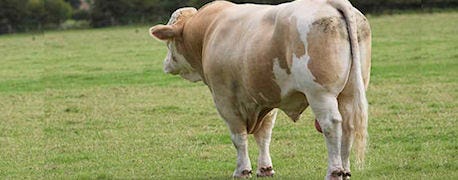March 21, 2014

Patrick Gunn, ISU Extension cow-calf specialist, often gets the question, "How much should I pay for a bull?"
"My first answer is 'Whatever the market will bear,'" he explained in a recent Iowa Beef Center Growing Beef newsletter.
Though he admits that answer gives no insight into return or investment for the producer relative to his or her traits of emphasis – ultimately, marketing goals – record prices show that desired traits translate to increased prices of replacement breeding stock, he says.
Gunn says it's difficult to determine the exact price a producer should spend on a bull, but there are multiple factors that can be considered to establish a base price.

Valuing a bull can be tricky business, but producers should factor in EPDs, says ISU cow-calf specialist
"Typical thumb rules that I have heard over the years for the value of an average purebred or composite bull include two times the value of a fed steer, five times the value of a feeder calf at weaning, or 25 times the hundredweight price of feeder calves," he says.
In the current market, using these thumb rules, the approximate range is $3975 to $4650, "which is very representative of early sale reports from 2014," he says.
Desired traits come at a premium
While spending less does not insinuate you have purchased an inferior bull, it should be expected that an above average bull for traits such as calving ease, weaning weight, docility, staybility, marbling, etc., will likely garner a premium.
"Assuming an average bull in today's market will be utilized for four years and mated to 100 cows, the mating fee over the life of the bull will be $43 per cow. Regardless of base price, for every $500 more spent on a herd sire, it raises the service fee only $5 per cow over the life of the bull," he says.
Related: EPDs 101: Selecting Bulls for Easy Calving
"Given today's feeder prices, for every $500 more spent on a herd sire, only three more pounds of weaning weight per calf would need to be obtained to offset the added investment on a sire improved growth [expected progeny differences]," he says.
"Similarly, only 0.5 more calves would need to be born to a sire with an improved calving ease EPD profile. Given the fluctuations in grid premiums and discounts, return on investment needed for bulls with improved carcass traits is harder to pinpoint, and will be specific to your operation."
Gunn says the initial investment of a bull in today's market may seem staggering, but it is an investment that adds immediate value to the herd working forward.
Planning for all possibilities is the best way to prepare for a successful calving season. But do it right! Download our free report, Best Practices for a Successful Calving Season, to ensure you have everything in place to limit stress on you and your herd.
Source: Iowa Beef Center
You May Also Like




